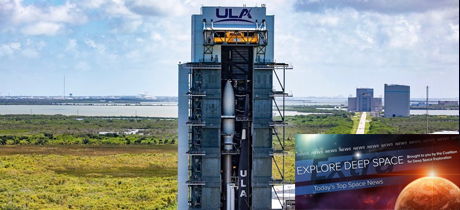In Today’s Deep Space Extra… There’s more to come on NASA’s 2021 budget as the full House begins consideration of the 2021 Commerce, Justice and Science bill today. Favorable weather awaits as NASA prepares to launch the Perseverance Mars 2020 rover on Thursday. Meanwhile, NASA’s Demo-2 test flight pilots, NASA astronauts Bob Behnken and Doug Hurley, are preparing to end their two month mission this weekend.
Space Policy
Irregular disorder and the NASA budget
The Space Review (7/27): 2021 does not appear to be the year in which the federal budget process returns to normal. With lawmakers focused on a response to the coronavirus pandemic, NASA’s budget has not had the benefit of budget hearings in either the House or the Senate. So far, the House Appropriations Committee has provided a signal that NASA may receive $22.6 billion for the 2021 fiscal year that begins October 1, which matches the agency’s 2020 budget. It’s not the $25.2 billion sought by the White House to support the return of human explorers to the surface of the Moon in 2024. The 2021 proposal that is scheduled to go before the full House this week includes just $628 million of the $3.3 billion sought by the White House for a commercial lunar Human Landing System (HLS). Some Earth and space science initiatives the White House sought to cut are funded in the House bill. A bipartisan amendment sought by eight House members seeks to provide the full $.3 billion for lunar landing system development but does not include offsetting reductions elsewhere. Meanwhile, the Senate has yet to address the 2021 budget.
Human Space Exploration
NASA, SpaceX preparing to bring Crew Dragon home this week
Ars Technica (7/27): On Wednesday, NASA and SpaceX will convene a Return Flight Readiness Review for the nearly two month Demo-2 test flight of a SpaceX Crew Dragon to the International Space Station (ISS) with NASA astronauts Bob Behnken and Doug Hurley. The review will select a splash down site among seven candidates on the Atlantic or Gulf side of the Florida Peninsula and a time for the return. The two astronauts launched and docked to the Space Station on May 30/31 for what became a productive extended mission. A successful return promises to lead to the Crew Dragon’s certification for regular scheduled launches of four astronauts to the orbiting science lab, perhaps starting in late September.
Space Science
Good weather predicted for NASA’s Mars rover launch Thursday
Coalition Member in the News – United Launch Alliance
Spaceflightnow.com (7/27): U.S. Air Force weather forecasters predict an 80 percent chance of favorable weather for the launch of a United Launch Alliance (ULA) Atlas V with NASA’s Perseverance Mars 2020 rover on Thursday between 7:50 a.m. and 9:50 a.m., EDT. The forecast improves to 90 percent favorable on Friday and back to 80 percent favorable on Saturday. The launch window closes on August 15.
How NASA found the ideal hole on Mars to land in
New York Times (7/28): Jezero Crater, the landing site selected by NASA with assessments from scientists for the Perseverance Mars 2020 rover, appears to have been an ancient lake on Mars with a stream delta. Once believed to have been warmer and wet, Mars is now cold and dry. Jezero is no exception. But if it once hosted microbial life, there should be clues in the mineral and chemistry makeup in the rocks and soil across the region. After it lands at Jezero in February 2021, the rover will collect and cache samples for return to Earth, perhaps in 2031, for analysis.
A new video captures the science of NASA’s Perseverance Mars rover
NASA Jet Propulsion Laboratory (7/27): This video offers an intriguing look at the seven science instruments assembled aboard the Perseverance Mars 2020 rover as it prepares for liftoff Thursday to further assess the past and present day habitability of Mars and pave the way for future human exploration.
NASA’s Ingenuity — the first ever off-world helicopter — is set for a ‘Wright brothers moment’ on Mars
Scientific American (7/27): NASA’s Perseverance Mars 2020 rover has a sidekick. Ingenuity is a small helicopter. After Perseverance touches down on Mars in February 2021, Perseverance will attempt to demonstrate the first powered flight on another planet. Up to five test flights of the small solar battery powered helicopter are planned in the thin Martian atmosphere. Future versions equipped with science instruments might be able to explore the sides of cliffs or crater walls where rovers and humans might not be able to reach.
Why the ‘super weird’ moons of Mars fascinate scientists
New York Times (7/25): Mars hosts two small moons, Phobos and Deimos. Scientists believe they merit robotic exploration, something NASA has so far not attempted to engage in. The former Soviet Union and Russia tried and failed three times. Japan, however, intends to attempt a Phobos sample return mission in 2024. Are the Martian moons remnants of the asteroid belt? Or products of a collision between planetary bodies? The chemistry from the sample may provide the answer.
Op Eds
What you should learn from Comet Neowise
The Space Review (7/27): Hariharan Karthikeyan is a California high school senior who overcame the many obstacles to catch a glance as well as a photo of comet Neowise. Now speeding away from the Earth and fading from view, this cosmic visitor will not return for another 6,800 years. “What many of us need in these challenging times is a sense of connectedness,” he writes. “When we think big, and zoom out, we gain a sense of context. We cease to define ourselves by the problems of today, but take everything in, holistically. Our accomplishments. Our ambitions. Our role in the cosmos, that gentle reminder that we’re all made from stardust.”

